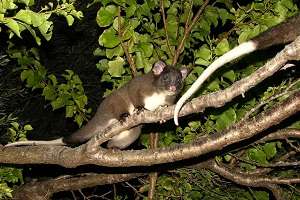Hot spells threaten ringtail habitat

THE potential impacts of anthropogenic global warming on the western ringtail possum (Pseudocheirus occidentals) have been explored in a recent Edith Cowan University research paper.
ECU School of Natural Sciences PhD candidate Shaun Molloy's paper on the possum, also known as the ngwayir, will be featured in Environmental Conservation's themed issue "Using Spatial Simulation Models to Plan for Persistence of Biotic Communities under Global Change".
Mr Molloy says nearly all living things have evolved to live within a spatial envelope, or potential distribution (PD), which is defined by bioclimatic parameters including rainfall, temperature range and seasonality.
"The ngwayir is listed as vulnerable and is currently down to about 10 per cent of its pre-European distribution – and its range continues to contract," he says.
"This species is prone to heat stress so, consequently, large numbers die during hot spells and it's reliant on relatively few tree species for all of its habitat needs."
Current climate change modelling indicates that by the end of the 21st century the mean temperature in south-western Australia will increase by 3-4C, while a decrease in rainfall of 30-40 per cent (over pre-2000 averages) can be expected.
"This is bringing about an increase in the frequency and intensity of hot spells and changing the PD of many tree species," Mr Molloy says.
"It stresses trees and changes their leaf chemistry, making them less suitable for ngwayir fodder, and lowers leaf moisture content, reducing the amount of water available.
"We believed it was important [that] the potential impacts of anthropogenic global warming on this species be modelled to make informed conservation management decisions."
They used three species distribution models and three 2050 global climate models and overlaid and compared nine future scenarios.
"Having the landscape where ngwayir is most likely to persist into the future enables conservation actions to become more targeted," Mr Molloy says.
"More remnant vegetation in that area can be brought into conservation estate and feral animal controls can be targeted to population, as can revegetation using the appropriate tree species.
"Relocation and connectivity projects can also be targeted in the landscapes where they will do more good for this species.
"Conversely, populations outside the core PD can be targeted for translocating animals to conserve genotypes, areas where relictual populations might persist can be preserved and sanctuary areas with irrigation and appropriate tree genotypes can be established."
Provided by SETI Institute
















